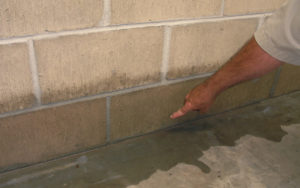Best Basement Waterproofing Can Be Fun For Everyone
Table of ContentsNot known Details About Best Basement Waterproofing The Facts About Best Basement Waterproofing UncoveredNot known Details About Best Basement Waterproofing Little Known Questions About Best Basement Waterproofing.All About Best Basement Waterproofing
AdvantaClean's trained specialists and specialists will find the water resource. If wall or slab fractures are present, we will inject polyurethane and epoxies into the splits and seal the compromise, protecting against additional dampness from entering.If there's condensation on the outside of the foil, you have high moisture in your basement. If the aluminum foil has condensation on the inside surface area (following to the wall), the dirt around your house might be naturally damp from a high water table or inadequate soil drain.
You can waterproof simply your interior walls, which might solve the issue. Once they dry out, they adhere permanently to concrete and stonework wall surfaces.
The Ultimate Guide To Best Basement Waterproofing
Concrete waterproof finishes can't be used to formerly repainted surface areas; inspect the label. Understood as densifiers, they are appropriate only for walls that haven't been painted or secured.
Yet you comb, roll, or spray it on far more thickly one gallon covers just 75 square feet, not the 300 square feet typical with conventional paint. Water-proof paint is great for DIY application. You can use it over repainted surfaces, and paint over it once it's cured (one gallon prices $37).
It can cost $10,000 to $15,000, depending on the job needed. Outside waterproofing involves digging deep into all around the home to the complete depth of the structure walls, after that setting up a water-proof layer or membrane covered by drainage panels.
A basement without waterproofing is kind of like that. Your basement doesn't desire to go via a downpour without appropriate protection just as much as you do not want to.
Things about Best Basement Waterproofing
Yet if you have actually done your research click to find out more study, you 'd understand there are two types of waterproofing: interior and exterior. It can obtain perplexing what they both mean, which one's a far better financial investment, and what will in fact maintain the water out. Do not fret, we put together this blog site to conveniently specify both techniques for you and go over the advantages and disadvantages of each.
Exterior waterproofing is a waterproofing method that involves securing your home from the exterior. It's type of like a moat around a castle. It involves digging a trench around your whole home down to the foundation (about 8 to 10 feet down). The structure wall surfaces are after that cleaned up, sealed, and covered with a water resistant membrane or sealer.

How Best Basement Waterproofing can Save You Time, Stress, and Money.
It's a much more engaged process that requires digging up your backyard, which is pricey and time-consuming. Exterior waterproofing includes eliminating every little thing bordering your house, including decks, driveways, sidewalks, landscape design, air conditioning systems, decks, and more. If any one of the job was done incorrectly and water is still entering your basement, there isn't much you can do to fix or repair it.
Inside cellar waterproofing includes waterproofing from the within. Any kind of water that leakages right into your cellar is redirected before it touches your floor. It's type of like putting on a raincoat under your garments. It involves two things: a water drainage track and a sump pump. It functions by securing the within your basement walls and floorings so water that attempts to enter is channeled out via a sump pump.
It's an effective method to waterproof your basement - Best Basement Waterproofing. The disadvantage of indoor basement waterproofing mostly has to do with the setup procedure. This technique calls for stored items, furniture, and integrated shelving or closets to be relocated from touching the cellar wall surfaces. And during installation, your basement can't be utilized. The largest distinction between the 2 methods is this: Outside waterproofing is a preventative option and indoor waterproofing is a rehabilitative solution.
An Unbiased View of Best Basement Waterproofing
Finally, exterior and interior cellar waterproofing are both efficient methods of protecting your home from water damages. Exterior waterproofing develops an obstacle that avoids water from entering your home, while interior waterproofing reroutes water that does enter your home. And it is necessary to note that outside waterproofing is a costly and disruptive installment go now process when compared to indoor waterproofing.
Whichever method you select, make certain you pick a trusted and credible service provider for the task. If you have any kind of questions regarding cellar waterproofing, please reach out to us.
You can fill up out our type below, start a conversation in the lower right-hand corner, or call us at 1-800-827-0702.